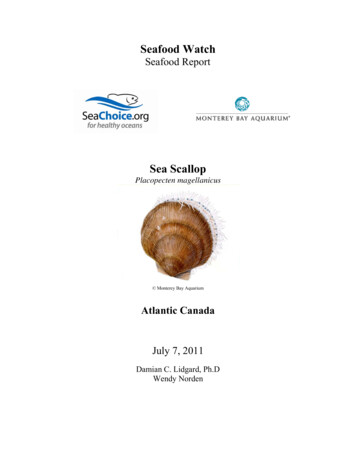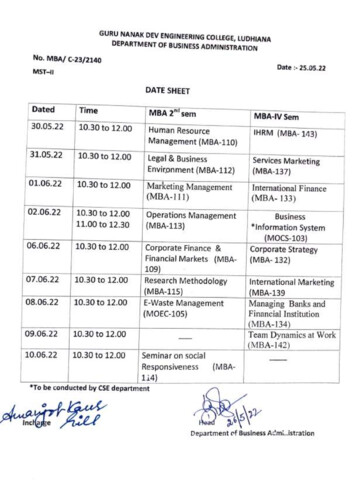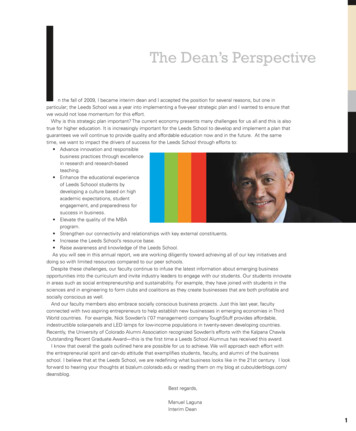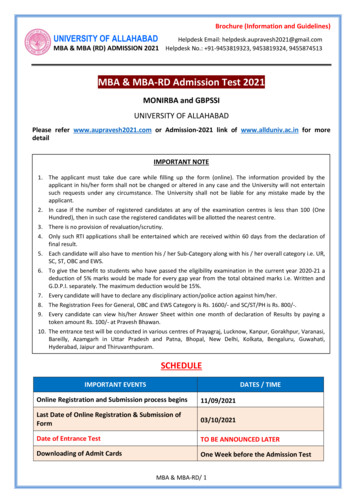
Transcription
Seafood WatchSeafood ReportSea ScallopPlacopecten magellanicus Monterey Bay AquariumAtlantic CanadaJuly 7, 2011Damian C. Lidgard, Ph.DWendy Norden
Seafood Watch and SeaChoice Atlantic Canada ScallopJuly 7, 2011About SeaChoice, Seafood Watch and the Seafood ReportsThis report is a joint product of SeaChoice and the Monterey Bay Aquarium Seafood Watch program. Bothorganizations evaluate the ecological sustainability of wild-caught and farmed seafood commonly found in theUnited States marketplace. In doing so, SeaChoice applies the definition of sustainable seafood and the methodfor its evaluation and presentation developed by the Seafood Watch program at the Monterey Bay Aquarium.Seafood Watch defines sustainable seafood as originating from species, whether wild-caught or farmed that canmaintain or increase production into the long-term without jeopardizing the structure or function of affectedecosystems.SeaChoice is a comprehensive seafood markets program with the primary goal of realizing sustainable fisheriesin Canada and abroad. SeaChoice uses the best available science, strategic communications and partnerships tomobilize sustainable seafood markets via six main programs: (1) research, (2) industry outreach, (3) publiceducation, (4) retail partnerships, (5) strategic communications, and (6) dialogue with government. Moreinformation on SeaChoice can be obtained at www.SeaChoice.orgSeafood Watch makes its science-based recommendations available to the public on our website(www.SeafoodWatch.org), print materials, an iphone app and other media. The program’s goals are to raiseawareness of important ocean conservation issues and empower seafood consumers and businesses to makechoices for healthy oceans. Each sustainability recommendation is supported by a Seafood Report. Each reportsynthesizes and analyzes the most science on a species, then evaluates this information against the program’sconservation ethic to arrive at a recommendation of “Best Choices”, “Good Alternatives” or “Avoid”. Thedetailed evaluation methodology is available upon request. In producing the Seafood Reports, Seafood Watchseeks out research published in academic, peer-reviewed journals whenever possible. Other sources ofinformation include government technical publications, fishery management plans and supporting documents,and other scientific reviews of ecological sustainability. Seafood Watch Research Analysts also communicateregularly with ecologists, fisheries and aquaculture scientists, and members of industry and conservationorganizations when evaluating fisheries and aquaculture practices. Capture fisheries and aquaculture practicesare highly dynamic; as the scientific information on each species changes, Seafood Watch’s sustainabilityrecommendations and the underlying Seafood Reports will be updated to reflect these changes.Parties interested in capture fisheries, aquaculture practices and the sustainability of ocean ecosystems arewelcome to use these seafood reports upon receiving permission and instructions for appropriate crediting fromthe Monterey Bay Aquarium and SeaChoice. For additional information about Seafood Watch , visitwww.seafoodwatch.org or call 1-877-229-9990. For more information about SeaChoice , please contact theSeaChoice program via e-mail and telephone information available at www.seachoice.org.DisclaimerSeaChoice and Seafood Watch strive to have all seafood reports reviewed for accuracy by external scientistswith expertise in ecology, fishery science and aquaculture. Scientific review, however, does not constitute anendorsement on the part of the reviewing scientists of SeaChoice or the SeaChoice program, or the SeafoodWatch program or their recommendations. SeaChoice and Seafood Watch are solely responsible for theconclusions reached in this report.SeaChoice, Seafood Watch and the seafood reports are made possible through grants from the David and LucilePackard Foundation.2
Seafood Watch and SeaChoice Atlantic Canada ScallopJuly 7, 2011Table of ContentsI. Executive Summary . 4II. Introduction. 6III. Analysis of Seafood Watch Sustainability Criteria for Wild‐caught Species . 12Criterion 1: Inherent Vulnerability to Fishing Pressure .12Criterion 2: Status of Wild Stocks .14Criterion 3: Nature and Extent of Bycatch .30Criterion 4: Effect of Fishing Practices on Habitats and Ecosystems .39Criterion 5: Effectiveness of the Management Regime .42IV. Overall Evaluation and Seafood Recommendation . 47V. References . 483
Seafood Watch and SeaChoice Atlantic Canada ScallopI.July 7, 2011Executive SummaryThis report is an evaluation of the Canadian sea scallop (Placopecten magellanicus) fishery. TheCanadian scallop fishery is conducted both offshore (including the Eastern Scotian Shelf,Georges Bank Banquereau, Middle Bank, Sable and Western Banks, Browns Bank, GermanBank and St Pierre Bank) and inshore (Bay of Fundy and Quebec). Depending on the area,scallop fishing occurs year-round. Fishermen target both inshore and offshore sea scallops withgear towed behind a vessel dragging large wire-mesh bags along the seafloor (dredge). Theoffshore dragger fishery uses both wet and freezer trawlers.Sea scallops are inherently resilient to fishing due to their high intrinsic population growth rate,high individual growth rate, low age at first maturity and high fecundity.The stock status of scallops varies by area. The offshore fishery has reduced its effortconsiderably in the last decade while maintaining high catch levels. Despite a long fishingrecord, offshore sea scallop stocks in Canada are not considered overfished. Recruitment in theBay of Fundy fishery is low. Stocks in Quebec are considered low in abundance with theexception of the North Shore area where catches have remained constant. In all areas, catcheshave been in decline since the opening of the fisheries. Department of Fisheries and Oceans(DFO) stock assessment reports cover one region at a time; stocks and data are not alwaysreported in the same manner. Knowledge of the overall population abundance of Canadian wildscallop stocks is fragmentary. Overall, stock status is considered to be a moderate conservationconcern for all stocks.Scallop dredges are known to catch many species in addition to their intended targets. Althoughthere has been recent research into some bycatch species (winter skate) and discards, historically,there is either limited or no long-term analysis. Bycatch may include some species listed as aconservation concern by COSEWIC, such as winter skate and Atlantic cod. However,management has implemented measures to constrain bycatch of these species. When data areavailable, these bycatch events have not shown any increase and, in some cases, have shown adecrease in recent years. In addition, recent data have shown high post-catch survivorship forwinter skate, and some measures have been implemented to reduce bycatch. Nevertheless, thereis a general lack of research on the quantity of bycatch and its impact on populations. Bycatchfrom the Canadian scallop fishery is rated as a moderate conservation concern.Scallop dredging impacts benthic habitats by altering physical and biological structures.Ecosystem effects have been detected but few studies have adequate controls comparing animpacted area to an area that has never been fished. Dredging can also impact populations ofscallops and result in both direct and indirect mortality (e.g., by altering important habitat) of thetarget species. Dredging for scallops is deemed to be a high conservation concern.The Department of Fisheries and Oceans (DFO) provides routine stock assessments with fisherydependent and fishery-independent data. Management has implemented good practices such aslimiting entry, restricting gear types, and establishing fishing areas, seasons, and buffer zones.Catches are monitored by an industry-funded dockside monitoring program, and several fisheriesrequire vessel monitoring systems. Historically, Canadian fisheries management has been faulted4
Seafood Watch and SeaChoice Atlantic Canada ScallopJuly 7, 2011for being slow to respond to benthic habitat destruction caused by scallop dredging. Recentseabed mapping (facilitated by industry and DFO cooperation) has led to a reduced footprint forthe dredge fishery but has also allowed vessels to target older brood stocks and access areaspreviously protected because of the potential for gear hang-ups. Overall, management of theCanadian scallop fishery is deemed a moderate conservation concern.Overall, the Canadian scallop fishery is considered a Good Alternative.The Eastern Canada offshore scallop fishery (St Pierre Bank, the Eastern Scotian Shelf, Brownsand German Bank, and Georges Bank) has been certified as sustainable to the MarineStewardship Council (MSC) standard. The MSC is an independent non-profit organization,which has developed an environmental standard for sustainable and well-managed fisheries. Ituses a product label to reward environmentally responsible fishery management and practices(http://www.msc.org/).Table of Sustainability RanksSustainability CriteriaInherent VulnerabilityConservation ConcernModerateHighLowCritical Status of StocksNature of Bycatch Habitat & Ecosystem Effects Management EffectivenessAbout the Overall Seafood Recommendation: A seafood product is ranked Best Choice if three or more criteria are of LowConservation Concern (green) and the remaining criteria are not of High or CriticalConservation Concern. A seafood product is ranked Good Alternative if the five criteria “average” to yellow(Moderate Conservation Concern) OR if the “Status of Stocks” and “ManagementEffectiveness” criteria are both of Moderate Conservation Concern. A seafood product is ranked Avoid if two or more criteria are of High ConservationConcern (red) OR if one or more criteria are of Critical Conservation Concern (black)in the table above.Overall Seafood Recommendation:Best ChoiceGood Alternative5Avoid
Seafood Watch and SeaChoice Atlantic Canada ScallopII.July 7, 2011IntroductionThis report is an evaluation of the Canadian sea scallop (Placopecten magellanicus) fishery. TheCanadian scallop fishery is conducted both offshore (including the Eastern Scotian Shelf,Georges Bank Banquereau, Middle Bank, Sable and Western Banks, Browns Bank, GermanBank and St Pierre Bank) and inshore (Bay of Fundy and Quebec). This report does not coverthe Gulf Region as this area accounts for only 2% of the total scallop landings in Canada (Malletet al. 2010).BiologyThe sea scallop (Placopecten magellanicus) is distributed in the northwest Atlantic from NorthCarolina north to Labrador. Within this area, scallops are found in large concentrations known asgeographically discrete beds. Sea scallops are single-sexed, bivalve mollusks. Both males andfemales reach sexual maturity at age four. Male scallop gonads are white and milky while femalegonads are bright red, both developing in the Canadian summer months. Fertilization is externalwith eggs and sperm released into the water column between August and October. Fertilizedeggs develop into larvae (veliger) in a few days and continue to develop through four larvalstages that feed on phytoplankton in the water column. This period of growth continues for 30 to60 days before the larvae settle on the bottom. The sea scallop prefers sandy, gravel bottoms anddepths of 35 to 120 m. Once settled, the postlarvae undergo a series of morphological changesbefore developing into juvenile scallops. The persistence of scallop aggregations (beds) inlocalized areas suggest that the spatial distribution of scallop beds is determined by availablesubstrate types and local hydrographic conditions that persist from year to year, such as gyres,upwelling and vertical mixing. These hydrographic features affect temperature, primaryproductivity, bottom currents and retention of scallop larvae. The growth of scallops is estimatedfrom annual rings on the shell. Growth rates vary geographically and according to time of year,depth and water temperature.FisheryThe Canadian sea scallop (Placopecten magellanicus) fishery is conducted in both inshore andoffshore waters. The main types of bottom gear used are Digby drags, ‘miracle gear’ drags (usedinshore) and New Bedford dredges (used offshore).6
Seafood Watch and SeaChoice Atlantic Canada ScallopJuly 7, 2011OffshoreAfter Canada declared a 200-mile fishing zone in 1977, disputes occurred over access to GeorgesBank between Canada and the USA. This dispute was settled in 1984 through the InternationalCourt of Justice (ICJ) confirming and establishing an international boundary in the Gulf ofMaine referred to as the “ICJ line” or “Hague line.” Canada was awarded the northeasternportion of Georges Bank. The Canadian offshore scallop fishery includes: Georges Bank, theEastern Scotian Shelf (Banquereau, Middle Bank, Sable and Western Banks (fishedperiodically), Browns Bank, German Bank and St Pierre Bank. In 1989, an Enterprise Allocation(EA) program for the management of the offshore scallop fishery was introduced to fix thepercentage of shares for each of the enterprises involved in the fishery. The Offshore ScallopAdvisory Committee (OSAC) is the management body for the offshore scallop fishery,composed of the major stakeholders and DFO. The OSAC makes recommendations on annualTotal Allowable Catches (TACs), administration of the EA program and other managementmeasures. Scallop resource on Georges Bank, which is the primary area fished, are assessedannually.The fleet consists of wet fish and freezer-trawler vessels. Both types of vessels use dual NewBedford dredges, from 4 to 6.1 m in width, one towed on each side of the vessel. Prior to 1998,Georges Bank was managed as a single unit but has since been managed as two distinct zones:‘Zone A’ (a shallower and more productive fishery) and ‘Zone B’ (deeper marginal habitat) withthe latter having a separate management plan (Fig. 1). Georges Bank ‘Zone A’ is managed with aTAC and a meat count of 33 meats per 500 g. In the Canadian scallop fishery, meat counts(which specify the number of meats allowed per unit weight; as average scallop meat size goesup, the meat count declines) were introduced in 1973 in an effort to maximize yield per recruit(Shumway and Parsons 2006). The scallop resource on Georges Bank 'A' are assessed annuallyon the recommendation of a 2009 framework assessment (Jonsen et al. 2009). Other offshorebanks are currently assessed on an ad-hoc basis. In the past, the determination of need for anassessment for these other areas has come through dialogue between the offshore fishingindustry and DFO. Currently, DFO intends to start a biannual assessment of Georges Bank andthe other offshore banks, but this has not been implemented to date. Prior to 2008, GeorgesBank ‘B’ was managed with a rolling TAC allocated in 200 t increments for a specified fishingperiod and a meat count of 40 meats per 500 g. In January 2008, the management system waschanged: the TAC was switched to a conventional model while the meat count per gram stayedthe same. In November 2004, to increase the yield of juvenile scallops, the offshore scallopindustry introduced voluntary closures of fishery areas on Georges Bank. Currently, there arethree closures for Zone ‘A’ on Georges Bank and three on Browns Bank.7
Seafood Watch and SeaChoice Atlantic Canada ScallopJuly 7, 2011Figure 1. Location of Georges Bank ‘A’ and ‘B’ (from DFO, 2009a).In 2008, the TAC for Zone ‘A’ was 5,500 t (with reported landings of 5,498 t) while Zone ‘B’had a smaller TAC of 400 t (with landings of 358 t). Prior to 2002, the fleet consisted mostly ofwet fish vessels but freezer-trawlers were then introduced. In 2008, ten wet fish and six freezertrawlers fished a portion of the season. The landings from freezer-trawlers have increased sincetheir introduction from 775 t during the first year (12% of the total landings) to 3,776 t fromZone ‘A’ (69% of total landings) and 265 t (74% of total landings) from Zone ‘B’ in 2008.The Bay of FundyThe Bay of Fundy scallop fishery is managed as six scallop production areas (SPA 1–6) and hasthree fishing fleets: Full Bay Fleet, Mid Bay Fleet and the Upper Bay Fleet. The Full Bay Fleet(with vessels of 45’ to 60’) has access to the entire Bay of Fundy, the Mid Bay Fleet (withvessels of 30’ to 45’) is permitted to fish only those areas north of the Mid Bay line, and theUpper Bay Fleet (also with vessels of 30’ to 45’) is restricted to the upper reaches of the Bay(Fig. 2). The fishery is regulated through limited entry, gear size limits, seasonal closures,minimum shell height, meat counts, and individual meat weight restrictions (Smith and Lundy2002a; Smith and Lundy 2002b). Gear width is restricted to 5.5 m (and a ring size of 82 mm,inside diameter). The Mid and Upper Fleets operate under a competitive quota while the FullBay Fleet operates under an Individual Transferable Quota (ITQ) system. Landings from allthree fisheries are reported by adductor muscle weight (referred to as the ‘meat’). Scallops areassessed annually according to a framework completed in 2002 (Smith and Lundy 2002a; Smithand Lundy 2002b).8
Seafood Watch and SeaChoice Atlantic Canada ScallopJuly 7, 2011Figure 2. Locations and place names for inshore scallop grounds (from DFO, 2009b).Scallop Fishing Area 29Scallop Fishing Area (SFA) 29 stretches from the inshore area (inside the 12-mile territorial sea)south of Yarmouth (latitude 43 40′N) to Cape North in Cape Breton (Fig. 2). It lies withinLobster Fishing Area 34, and the two fisheries consult with each other to minimize conflict.Lobster fishermen have expressed concern about the impacts of scallop fishing as LFA 34 is oneof the best lobster fishing areas in Atlantic Canada. Lobster bycatch was minimal in 2001 despitehigh scallop catch rates. The impact on the lobster fishery is measured only by lobster bycatch,which continues to be monitored in this fishery.The Full Bay Scallop Fleet fished in this area until 1986, after which it was restricted to the areanorth of latitude 43 40′ N in accord with the 1986 inshore/offshore scallop fishing agreement.From 1996 to 1998, a limited fishery for this fleet was approved. In 2001, the Full Bay Fleet wasgranted access once again with a full at-sea monitoring program and the condition of a postseason industry-funded survey. In the following year, access was granted to this fleet and tolicense holders who are eligible to fish inshore in SFA 29 east of Baccaro and west of longitude65 30′W. Historically, SFA 29 inshore scallop licenses were restricted to east of Baccaro (east oflongitude 65 30′ W). A joint project agreement was signed with the fishing fleets, Natural9
Seafood Watch and SeaChoice Atlantic Canada ScallopJuly 7, 2011Resources Canada, and Fisheries and Oceans Canada with all parties providing funds to conductmulti-beam acoustic mapping of the seafloor and other scientific work. A map showing bottomfeatures for the entire area was prepared and distributed to the fishermen for the 2004 fishery.Work continues on analyzing surficial geology and the spatial distribution of scallops. Advice onTACs for this area is provided annually based on tracking the response of survey estimates ofabundance to catches in the previous year. There are no framework or reference points for thefishery in SFA 29 at this time. Landings have ranged from 221 t to 713 t.Inshore QuebecThe inshore commercial scallop fishery in Quebec began in the late 1960s and targets the twospecies of scallop in the area interchangeably (the sea scallop and Iceland scallop, Chlamysislandica). These two species are found mainly on gravel, shell or rocky bottoms, generally atdepths of 20–60 m.Figure 3. Inshore scallop fishing areas in Quebec (DFO, 2007b).Over the years, there has been a substantial increase in fishing effort, primarily as a result of thefleet’s increased capacity and efficiency, but since 2007 there has been an overall 29% decline ineffort for the inshore Quebec fishery (DFO 2010).The region is divided into 18 management units grouped into three sectors: the North Shore, theGaspé and the Magdalen Islands. There are 80 permanent fishing licenses and two exploratorylicenses as of 2006 (DFO, 2007b; Fig. 3). Fishing effort is controlled in all units. Most units onthe North Shore and around Anticosti Island are also governed through quotas. The North Shoreregion has posted the largest scallop landings in Quebec since 1985 (DFO 2005c). In 2004,landings totaled more than 127 t of meat, down by 21% from 2003. The North Shore accountedfor 82% of the landings, followed by the Magdalen Islands with 14%, and the Gaspé with 4%.Fishing effort also decreased by 34% in 2004 (DFO 2005c).10
Seafood Watch and SeaChoice Atlantic Canada ScallopJuly 7, 2011Availability of ScienceScience is readily available and accessible in the form of regular stock assessments and scientificreports (DFO 2006; Smith et al. 2007). In the offshore fishery, the industry provides vessels andcrew as a cost-sharing agreement with DFO to conduct annual surveys and mapping of the seafloor (DFO 2006). In addition, some independent investigations have been conducted into theimpacts of the scallop fishery on the sea floor (Kenchington et al. 2007). More research isrequired to fully assess the impacts of these extensively used gear types. Some data on bycatchare from government reports but are generally either limited to certain regions or not consistentlyreleased (Benoît et al. 2010; Gavaris et al. 2010). In addition, independent fishery observer dataare not easily accessible. Previous reliance on logbooks (not intended to provide bycatchinformation) has resulted in poor historical data, but increases in observer coverage haveimproved recent data collection.Market AvailabilityThe adductor muscle, referred to as the ‘eye’, is the main edible part of the scallop, althoughseveral regions in the world prefer whole scallops with gonads attached. Given that scallops areactive swimmers and use this muscle to open and close their shell generating a motion thatpropels them through the water, the muscle is more developed in the scallop than in othershellfish such as oysters and clams. The color of the raw meat varies from creamy white toslightly orange due to the algae they consume.Prices fluctuate depending on the market and size. Scallops can sell for 13 USD per lb. Thelanded value of scallops in Eastern Canada in 2005 was over 88 million, making it the fourthmost valuable fishery in Atlantic Canada after lobster, snow crab and shrimp. Major importersof Canadian scallops are the US and France with 52% and 26%, respectively, of the 2009 totalCanadian exports value (Mallet et al. 2010). In 2010, the United State imported over 3,000 tons,valued at over 52 million USD, which represents approximately 14% of the scallop imports intothe United States (NMFS 2011).Common and market names: scallop, sea scallop, digby scallop, pétonclesSeasonal availability: Available year round in North AmericaProduct forms: Scallops come fresh or frozen. In Quebec, whole scallops (with roe attached)are an aquaculture product and can be purchased, but the majority of the seafood product is theadductor muscle.11
Seafood Watch and SeaChoice Atlantic Canada ScallopJuly 7, 2011III. Analysis of Seafood Watch Sustainability Criteria for Wild-caught SpeciesCriterion 1: Inherent Vulnerability to Fishing PressureThe commercial value of the scallop fishery as well as its relatively sedentary lifestyle hasresulted in significant research on assessing life history characteristics relevant to fisheriesmanagement. There is information on growth parameters, reproductive potential, andrecruitment. Less attention has been paid to intrinsic rates of increase or maximum age. Researchon juveniles and habitat preferences has also been conducted. Difficulty assessing juveniles hasmade year-class estimates challenging.Sea scallops are single-sexed, releasing eggs or sperm in the water column where externalfertilization takes place. Other benthic invertebrates with this mode of reproduction have beenshown to be vulnerable to the Allee effect, where reproduction is reduced or eliminated below acertain population density, although this has not been directly observed in sea scallops. Similarly,higher population densities would be expected to enhance recruitment as fertilization successincreases, but evidence for strong stock-recruitment relationships is equivocal. McGarvey et al.(1992) documented an exponential increase in the recruitment of sea scallops with stock size. Incontrast, more recent data analyzed by the Northeast Fisheries Science Center (NEFSC) foundlittle indication of recruitment driven by biomass (NEFSC, 2004). A better understanding ofstock-recruitment relationships is necessary to more precisely determine density and populationsize effects on recruitment at both high and low densities.Sea scallops grow quickly, reaching maturity at age four, although individuals less than fiveyears of age may contribute a small amount to the population gamete pool (McGarvey et al.1993). Scallops continue to grow quickly during their first few years of life, increasing in lengthby 50–80% between the ages of three and five years. The scallops’ von Bertalanffy coefficientfor Canada is 0.375. (Palomares and Pauly 2011) There is a positive relationship betweenfecundity and shell height (Langton et al., 1987b). Maximum egg production is not reached untilseveral years after maturity. Maturity is reached at age four (85–90 mm) when a female mayrelease up to two million eggs with maximum egg production closer to 270 million eggs(Langton et al., 1987b). However, only approximately 1–6 % of these will be fertilized, survivethe planktonic larval phase, and reach maturity (Barber and Blake 1991; McGarvey et al. 1992).This estimate is highly variable and reflects the density dependent stock-recruitment relationship.Scallops are relatively long lived; estimates of life-span range from 18–29 years (Bricelj andShumway, 1991). They prefer a sandy gravel bottom, which is unlimited in the North Atlanticand has not been impacted by disturbance other than fishing (DFO, 2009a). Scallops exhibit twobehaviors that may make them more vulnerable to fishing pressure: (1) they form aggregations,known as beds, and (2) they have a patchy distribution (Langston et al. 1987b).12
Seafood Watch and SeaChoice Atlantic Canada ScallopJuly 7, 2011Table 1. Life history characteristics of the sea scallop (Langton et al., 1987b, Thouzeau et al., 1991, Hart andChute, 2004; NEFSC, 2007).Intrinsicrate ofincreaseMedianage atmaturityyrsGrowth rates,vonBertalanffy kMax.age yrsMax.size cmFecunditySpecies rangeSpecialbehavior40.37518 to2914.2 to15.3up to 270millionNorth CarolinatoNewfoundlandlts ps’ inherent vulnerability to fishing pressure is considered a low conservation concern dueto their high individual growth rate, low age at first maturity and high fecundity.Inherent Vulnerability Rank:ResilientModerately Vulnerable13Highly Vulnerable
Seafood Watch and SeaChoice Atlantic Canada ScallopJuly 7, 2011Criterion 2: Status of Wild StocksFactors 1, 2 & 3: Management classification status, abundance thresholds and occurrence ofoverfishingGenerally, the Canadian stock assessment process does not specify stock status in terms of BMSY.The scallop fishery is not assessed according to reference points (although DFO will beformulating reference points for some scallop stocks in the future) that would characterize it asoverfished or demonstrate whether overfishing was occurring. Standard groundfish assessmentapproaches have been found to be inappropriate for sea scallops due to their sedentary lifestyle,which shows non-random aggregations of both biomass and age (MSC 2010). Althoughuncertain, it does not appear that scallop stocks are overfished or experiencing overfishing.However, current population abundance relative to BMSY and fishing pressure relative to Fmsyare unknown, and each of these three factors receives a yellow ranking.OffshoreThe scientific advice on TAC for the offshore scallop fisheries is based on abundant scientificinformation (Table 2). Georges Bank (the main fished area) has seen relatively stable TAC andlandings since 1990. The 2008 TAC was set at 5500 t based on evidence from the survey andcommercial catch data showing a recent steady increase in the stock and above average incomingrecruitment (DFO 2008b). In addition, scallop catch for all offshore areas has been relativelystable over time, although less than during the 1970’s (Figure 4).Figure 4. Scallop catches for all offshore areas, 1996–2006. Figure from Stevens et al. 2009.14
Seafood Watch
Maine referred to as the "ICJ line" or "Hague line." Canada was awarded the northeastern portion of Georges Bank. The Canadian offshore scallop fishery includes: Georges Bank, the Eastern Scotian Shelf (Banquereau, Middle Bank, Sable and Western Banks (fished periodically), Browns Bank, German Bank and St Pierre Bank.










